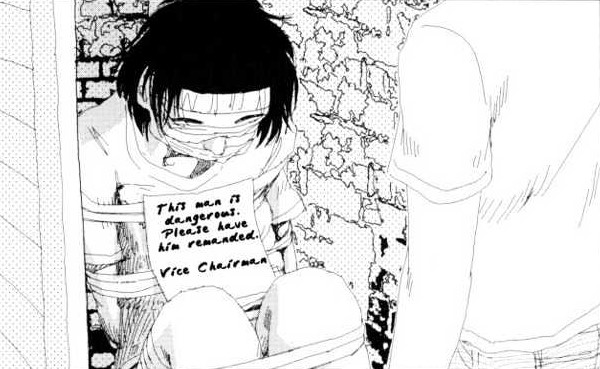The structure of cults has always been an object of fascination within media and pop culture, particularly (and seemingly inevitably) when the group turns to violent actions to further drive a flawed and delusional belief system. Intrinsically, these groups are not structured to thrive in a modern day society to the point of being considered normal (even looking at modern globally relevant organization), with members often perceived as flawed or taken advantage of. “Believers”, which was inspired by both the “The Aum Shinrikyo” and the “Japanese Red Army” focuses the cult mentality on three individuals undergoing a spiritual program, which is based around self sufficiency on an island.
Buy This Title
Each character within “Believers” has been stripped of name, instead given a title and ranking. This mimics a common technique of destroying any sense of identity and replacing it only with a structure of command through entitlement. At the top is the ‘chairman', the one who is supposed to be closest to the teachings of the ‘master' and an authority figure that dictates rituals to the underlings ‘vice chairperson' and ‘operator'. Unsurprisingly, this system becomes abused, degrading into (essentially) violence and torture. At first the abuse is minimal and falls more within the cult's ideologies, but as they begin to run out of food, coupled with the two lower ranking members beginning a sexual relationship, the ‘chairman' begins to abuse his role in order to take the female subordinate as his own partner. Overall, “Believers” presents the harrowing microcosm of the inherited abuse structure of cult mentality by focusing on three members.

The manga, while encapsulating the functions of a large corrupt cult, also offers up another interesting narrative view in presenting a dying cult. When we are first introduced to the characters, they are running out of food and drinking water, with deliveries rarely coming, and almost unusable when they do arrive, hints at problems with the supply chain. Additionally, a magazine comes to shore which contains news on the dissolution of their cult, and later passengers from a capsized boat tell them of their leader being under sexual abuse allegations. What makes this angle fascinating is getting the perspective of those being ‘left behind' and having to deal with the internal strife caused by being abandoned by, what is essentially, their god. Ultimately, almost all cults have their surviving members (i.e. “Jonestown” having a division outside of the compound at the time of the mass suicide), and the stories from survivors paint a fascinating portrait of a largely incomprehensible existence. “Believers” does an admirable job of covering the fallout in a way that feels genuine, at least in researching cult mentality.
As engaging as the narrative is, it is not without faults, most notably within creating a proper definition of the cult. Their belief system remain vague, largely in part to an interesting approach from Yamamoto, which starts the manga with the caveat that certain words are in fact so unique to the cult, that he decided to sub in appropriate translations, but that the reader can apply their own words within certain highlighted text. At first this choice adds some intrigue, but as certain terms become overused such as ‘dream' and ‘purification', the concept of them being an abstract concept to these individuals begins to devalue the language. This does become somewhat reflective of brainwashing systems that make followers subservient, much in the way of devaluation through removing names. However, it still feels a bit awkward in execution and becomes more of an annoyance as the story progresses.
The plot also presents some undesirable means of trying to convey its message, within a later chapter that shoehorns in the cults history. With a story which relies on fascination in the process and an organization which could be every or any cult, this seems rather unnecessary and negates the idea of the self interpretation from the reader. Thankfully, the conclusion is masterfully handled (not to be spoiled) and kind of sugar coats the awkward backstory in the previous chapter.

“Believers” is not strongly defined by its visual style, which feels slightly crude and almost rushed in points. However, it is notable that this project was completed by Yamaoto without any assistants helping him in the process. One aspect of the art that seems well explored is the erotic , which does capture the desperation of pent up sexual frustration over a long period of time. It explores this by putting forth many panels focused on physical interaction leading up to and including sex acts. Even through censorship, the importance of the erotic aspects of the manga is apparent in the artistic approach, as it is also a key factor in exploring the dissolution of the cult.
“Believers” is by no means a masterpiece, with a narrative that can be oversimplified and containing unnecessary narrative shifts. The artwork is also rather uninspiring, even when giving some understanding towards the process. However, there is a lot within the concept of representing cults that is fascinating and gives the impression that Yamamoto took great care in research to try accurately present the inner workings of cult mentality. The work also explores various genres with elements of, horror, romance, drama and eroticism, with all of them being well balanced. The manga will also hold appeal towards those who have an interest in cults, which includes myself (studying not participating). There is a lot to enjoy about this obscure manga, and having read it many years agom a lot of the imagery and plots really stuck with me, particularly the ending which leaves with a strong, albeit tragic, portrait of a mind in ruin. “Believers” is a manga that deserves a wider audience.
















